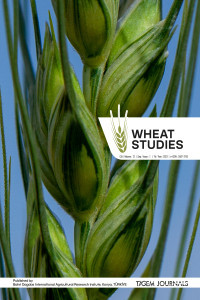Bazı Herbisitlerin Mısır ve Yabancı Ot Biyomasına Etkisi
Bu çalışma bazı herbisitlerin mısırın ve yabancı otların biyomasına etkilerini incelemek amacıyla yürütülmüştür. Araştırma 2016 yılında tesadüf parsellerinde faktöriyel deneme desenine göre 4 tekerrürlü olarak, tam kontrollü sera şartlarında, glpyhosate, glufosinate, imazamox ve isoxaflutole + thiencarbazone-methyl + cyprosulfamide etken maddeli herbisitlerin saksılara ekilen 25 mısır hattına uygulanmasıyla gerçekleştirilmiştir. Mısır biyoması en az glpyhosate, en fazla isoxaflutole + thiencarbazone-methyl + cyprosulfamide etken maddeli herbisit uygulanan mısır hatlarında elde edilmiştir. Yetiştirme ortamında bulunan yabancı ot tohumlarının çimlenmesi ve büyümesi ise en az isoxaflutole + thiencarbazone-methyl + cyprosulfamide (safener), en fazla glpyhosate uygulanan saksılarda ortaya çıkmıştır. İsoxaflutole + thiencarbazone-methyl + cyprosulfamide etken maddeli herbisitle sonradan çimlenme potansiyeli bulunan yabancı otlara karşı kontrol sağlandığı düşünülmektedir.
Anahtar Kelimeler:
Biyomas, herbisit, mısır, yabancı ot
The Effect of some Herbicides on Maize and Weed Biomass
This study was conducted to investigate the effects of some herbicides on the biomass of maize and weeds. The study was carried out by applying the randomized parcels with four replications according to the factorial design pattern, in the fully controlled greenhouse conditions, glpyhosate, glufosinate, imazamox and isoxaflutole + thiencarbazone-methyl + cyprosulfamide active ingredient herbicides, on potted 25 maize lines in 2016. It was obtained the least maize biomass with glpyhosate, and the most one with isoxaflutole + thiencarbazone-methyl + cyprosulfamide active ingredient herbicides were applied. The germination and growth of weed seeds in the growing medium occurred the most with glpyhosate, the least one in the pots was applied with isoxaflutole + thiencarbazone-methyl + cyprosulfamide (safener). It has been thought that isoxaflutole + thiencarbazone-methyl + cyprosulfamide active herbicide which controlled against weeds have potential for germination afterwards.
___
- Berzsenyi, P., Bonis, B., Arendas, T. (1995). Investigations about the effects of some factors influencing the efficacy of postemergence weed control in maize (Zea mays L.), Dang Quoc Lap, Agricultural Research Institute of The Hungarian Academy of Sciences, 9th EWRS Syposium Budapest, 257 – 264.
- Boz, Ö., Unay, A., Doğan, M. N., Şimşek, S., Arat, B. B., Keşşaf, D. (2015). Tavsiye dışı uygulanan herbisitlerin kültür bitkisi üzerinde oluşturduğu simptomlar. Adnan Menderes Üniversitesi Ziraat Fakültesi Araştırma (Tez Hariç) Kitabı, 41-66.
- Doğan, I., Dok, M., Altop, E. K., Mennan, H. (2015). Mısır yetiştiriciliğinde erken toprak işleme ve Glyphosate’nin çıkış öncesi ve çıkış sonrası yabancı ot mücadele yöntemleri ile birlikte kullanılabilirliğinin araştırılması. Tarım Bilimleri Dergisi, 21, 596- 605.
- Gizem, H. (2015). Herbisitlere dayanıklı transgenik bitkiler. http://www.istanbul.edu.tr/fen/notlar /1260103398.ppt (Erişim Tarihi:15.12.2015).
- Leonard, G., Sankula, S., Reigner, N. (2003). Maize – Herbicide-tolerant case study, potential ımpact for ımproving, pest management in European agriculture, The National Center for Food and Agricultural Policy.
- Tan, S., Evans, R. R., Dahmer, M. L., Singh, B. K., Shaner, D. L. (2005). Imidazolinone-tolerant crops: history, current status and future. Pest Manag Sci ,61: 246–257.
- Thonke, K. E. (1991). Political and practical approach in Scandinavia towards reducing herbicide inputs, Brighton Crop Protection Conference, Brighton, 1183 –1190.
- Torun, H., Uygur S. (2012). Herbisit uygulamalarının bazı kültür bitkileri üzerinde oluşturduğu zararlanmalar. Türkiye Herboloji Dergisi, 15(1-2), 1-12.
- Uysal, B. (2012). Farklı dozlarda kullanılan bazı herbisitlerin mısırda yabancı otlanmaya etkisi. Gaziosmanpaşa Üniversitesi Fen Bilimleri Enstitüsü, Yüksek Lisans Tezi.
- Yayın Aralığı: Yılda 2 Sayı
- Başlangıç: 2021
- Yayıncı: BAHRİ DAĞDAŞ ULUSLARARASI TARIMSAL ARAŞTIRMA ENSTİTÜSÜ
Sayıdaki Diğer Makaleler
Selvi Sirkenin (Atriplex nitens Schkuhr) Alternatif Kullanım Potansiyelinin Araştırılması
Ramazan ACAR, Abdullah ÖZKÖSE, Nur KOÇ
Bazı Herbisitlerin Mısır ve Yabancı Ot Biyomasına Etkisi
Recep YAVUZ, Mesut ESMERAY, Vesile URİN
İrfan ÖZTÜRK, Turhan KAHRAMAN, Remzi AVCI, Vedat Çağlar GİRGİN, Tuğba Hilal ÇİFTÇİGİL, Adnan TÜLEK, Bülent TUNA
